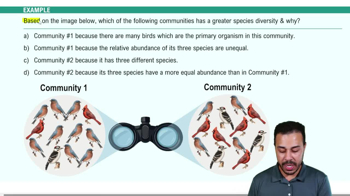Community Structure definitions Flashcards
 Back
BackTerms in this set (13)
Community structure
The organization of a biological community based on species diversity, interactions, physical environment, and trophic structure, influencing ecosystem function and resilience.
Species Richness
The count of distinct species present in a given ecological community, reflecting its biodiversity.
Relative Abundance
The proportion of individuals of a particular species compared to the total number of individuals of all species in a community.
Species Diversity
A measure combining the number of species (richness) and their relative abundance in a community, reflecting both variety and balance of species present.
Trophic Structure
The transfer of energy through different levels in a food chain or web, from producers to various levels of consumers, illustrating who eats whom and the efficiency of energy transfer.
Food Chain
A linear sequence of organisms where each is eaten by the next, transferring energy from producers to various levels of consumers.
Food Web
A complex network of interconnected food chains in an ecosystem, illustrating how different species are linked through various feeding relationships.
Dominant Species
A species that predominates in a community due to its high abundance or biomass, significantly influencing the structure and function of the ecosystem.
Keystone Species
A species that has a disproportionately large impact on its ecosystem relative to its abundance, often maintaining the structure and health of the community.
Ecosystem Engineers
Organisms that significantly modify, create, or maintain habitats, affecting the availability of resources and the structure of the ecosystem.
Disturbance Regime
A recurring pattern of environmental disturbances, such as wildfires or storms, that shape and influence the structure and composition of an ecosystem over time.
Intermediate Disturbance Hypothesis
Moderate disturbances in an ecosystem promote the highest species diversity by preventing dominance by a few species and allowing coexistence of many.
Biogeography
Study of the distribution of species and ecosystems in geographic space and through geological time, influenced by factors like latitude, climate, and area size.



